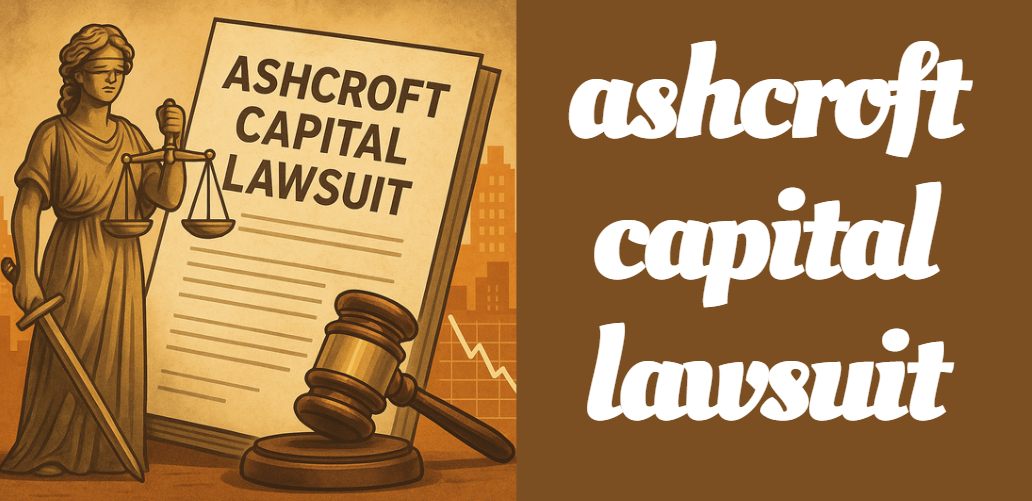The Ultimate Guide to the ashcroft capital lawsuit
The ashcroft capital lawsuit is more than just a legal dispute; it is a significant event in the world of real estate syndication and investment. This guide explains why the lawsuit matters, highlighting how misrepresentation, breach of fiduciary duty, and improper fund allocation can affect investor trust and market stability.
With rising investor concerns and increasing scrutiny over financial management practices, understanding this case is essential for anyone involved in, or considering, investments in real estate funds.
Background of Ashcroft Capital
Ashcroft Capital has long been known as a prominent private equity firm specializing in multifamily property investments. The company built its reputation by acquiring, renovating, and managing apartment communities across the United States, promising attractive returns to its investors.
Founded by experienced industry leaders, Ashcroft Capital embraced a multifamily syndication model that allowed investors to pool their funds and benefit from diversified real estate portfolios without the hassles of day-to-day management.
Before the lawsuit emerged, Ashcroft Capital was highly regarded for its strong track record and transparent communication with its stakeholders. The firm’s leadership, renowned for their real estate expertise, maintained robust investor relations and consistently delivered on promised returns. However, recent legal challenges have cast a shadow over its operations, leading to a closer examination of its business practices.
Overview of the Lawsuit
The ashcroft capital lawsuit was initiated following complaints from a group of investors who alleged that the firm engaged in deceptive practices. The lawsuit focuses on several critical issues that, if proven true, could have far-reaching consequences.
Investors claim that they were misled about the profitability and risks associated with their investments due to inaccurate or exaggerated information provided by Ashcroft Capital. The legal action aims to hold the company accountable for any financial losses incurred by its investors and to restore trust within the investment community.
The case was filed in a specified jurisdiction and involves both individual investors and institutional stakeholders. While the proceedings are complex, they are fundamentally about ensuring that investment firms uphold their fiduciary responsibilities and maintain transparency in their dealings.
Detailed Analysis of the Allegations
The heart of the ashcroft capital lawsuit lies in several core allegations. Investors contend that Ashcroft Capital misrepresented investment returns, breached its fiduciary duty, misused investor funds, and violated regulatory requirements.
A key allegation is the misrepresentation of investment returns. Many investors feel that the firm provided overly optimistic projections and marketed its deals with inflated promises that did not match actual performance.
Another grave claim is the breach of fiduciary duty, where it is alleged that Ashcroft Capital placed its interests ahead of those of its investors by failing to disclose material conflicts of interest and by not prioritizing transparency.
Additionally, there are allegations concerning improper fund allocation. Critics argue that investor capital was diverted towards non-essential expenses instead of being used to enhance the investments. Finally, regulatory violations have been cited, with claims that the firm did not adhere to proper disclosure standards as required by securities laws. The following table summarizes these allegations clearly:
| Allegation | Description |
|---|---|
| Misrepresentation of Returns | Claims that the firm exaggerated financial performance and misled investors about potential returns. |
| Breach of Fiduciary Duty | Allegations that investor interests were ignored in favor of corporate profit or personal gain. |
| Improper Fund Allocation | Accusations that investor funds were misdirected towards unrelated or non-essential expenses. |
| Regulatory Violations | Claims of failing to comply with securities laws and inadequate disclosure of risks. |
Legal Proceedings and Timeline
The legal journey of the ashcroft capital lawsuit began when investors noticed discrepancies and raised concerns that eventually led to formal legal action. The timeline of events has several important milestones.
Initially, investors filed the lawsuit in response to what they perceived as egregious mismanagement practices. Subsequent legal actions included motions for preliminary injunctions, during which the court scrutinized the firm’s business practices and the adequacy of its disclosures.
Throughout the litigation process, both sides have engaged in extensive discovery, gathering depositions from key executives and financial officers. This phase has unearthed detailed financial records and internal communications, providing a basis for the claims and the defense alike. Regulatory bodies such as the SEC have also taken notice, adding another layer of complexity to the proceedings.
The timeline, presented in the table below, highlights some key dates in the legal process:
| Event | Description |
|---|---|
| Filing of the Lawsuit | Investors filed legal claims against Ashcroft Capital. |
| Preliminary Injunction Hearing | Court considered motions to limit the firm’s operations pending case resolution. |
| Discovery Phase | Extensive gathering of financial records and depositions from key personnel. |
| Ongoing Hearings and Motions | Several motions regarding evidence and the validity of claims continue to be heard. |
| Current Status | The case remains ongoing with potential for settlement or trial outcomes. |
Impact on Investors and the Real Estate Industry
The ashcroft capital lawsuit has significant implications for both individual investors and the broader real estate market. Investors who have placed their capital in Ashcroft Capital are now facing uncertainty, with potential risks of delayed returns or even capital losses.
For many, this lawsuit serves as a cautionary tale about the importance of transparency and thorough due diligence when choosing investment partners.
This legal battle is also prompting a re-evaluation within the entire private equity real estate sector. With increasing calls for greater accountability, investors are now more demanding detailed disclosures and stringent risk management practices. The outcome of this lawsuit may lead to enhanced regulatory oversight and a push for industry reforms, which could transform how investment firms operate in the future.
A brief list within this section might outline key impacts:
- Investors may demand more detailed financial reporting.
- There could be a potential decrease in deal volume as confidence wanes.
- Regulatory bodies might enforce stricter compliance measures.
- Future syndications could face higher transparency requirements.
Defense, Response, and Public Reactions
Ashcroft Capital has responded to the ashcroft capital lawsuit by strongly denying all allegations of wrongdoing. The firm maintains that its business practices have always been ethical and that all potential risks were adequately disclosed.
In public statements and press releases, Ashcroft Capital emphasizes its proven track record and insists that any discrepancies in financial performance were the result of market fluctuations rather than intentional misrepresentation.
The company’s legal team is working tirelessly to refute the claims and has presented counterarguments that challenge the credibility of the plaintiffs’ evidence. They argue that the misinterpretations of financial data and investment risks do not constitute fraudulent activity.
Public and industry reactions have been mixed, with some experts defending the firm’s practices while others call for greater regulatory scrutiny to prevent similar situations in the future.
Lessons Learned and Recommendations for Investors
The ashcroft capital lawsuit offers several important lessons for both investors and investment firms. It underscores the necessity of conducting thorough due diligence before committing to any investment. Investors should always review financial documents in detail, verify the track record of the syndicator, and understand all associated risks.
Key strategies for investors include demanding full transparency, engaging independent advisors, and diversifying investments to minimize potential losses. For investment firms, the case highlights the crucial need for clear communication, ethical management practices, and robust internal controls to build and maintain investor trust.
A short list summarizing investor recommendations may include:
- Conduct meticulous research on investment partners.
- Insist on complete and timely disclosure of financial information.
- Diversify investment portfolios to spread risk.
- Consult independent financial and legal experts before investing.
Future Outlook and Potential Outcomes
The future of the ashcroft capital lawsuit remains uncertain. The case could ultimately be resolved through a settlement, which might involve financial compensation, changes in management practices, or enhanced regulatory oversight. Alternatively, if the case goes to trial and Ashcroft Capital is found liable, the firm could face significant financial penalties and further damage to its reputation.
The outcome of this legal battle is likely to have lasting effects on the real estate syndication industry as a whole. Increased regulatory scrutiny and stricter compliance measures might become more prevalent, fundamentally altering how real estate investment firms operate in the future.
Frequently Asked Questions
What best practices can investors follow to independently verify a firm’s financial transparency?
Before committing capital, investors should verify a firm’s disclosure documents, examine audited financial reports, and compare performance metrics with industry benchmarks. This process may involve consulting independent third-party financial analysts or using specialized investor tools. In addition, cross-referencing multiple data sources and seeking the advice of experienced professionals can add an extra layer of protection when evaluating the credibility of a real estate investment firm.
How do independent audits and third-party reviews help protect investor interests?
Independent audits provide an objective review of a firm’s financial health and compliance with disclosure regulations, ensuring that internal reports accurately reflect the state of investments. Third-party reviews, including ratings and opinions from industry watchdogs, serve as an external check against possible biases in the firm’s reporting. Investors who rely on these independent assessments often experience increased confidence in the management of their assets and can make more informed decisions.
What strategies can potential investors use to research the legal history of a real estate firm?
When considering an investment, potential investors should research any past legal proceedings involving the firm. This can be accomplished by reviewing public court records, using online legal databases, and reading news articles or industry reports that discuss previous lawsuits. Engaging with community forums and investor feedback can also provide insight into a firm’s track record regarding legal disputes, thus aiding in a more informed decision-making process.
What potential regulatory changes might be driven by cases similar to the Ashcroft Capital lawsuit?
Legal disputes in high-stakes real estate investments often prompt regulatory bodies to reexamine industry practices. Future changes could include stricter disclosure requirements, enhanced reporting standards, and more rigorous audits of investment funds. Regulators may also introduce additional safeguards aimed at protecting investors and ensuring that all parties maintain a higher level of accountability in financial dealings.
How could broader market trends affect investor confidence in private real estate investment firms following legal challenges?
Legal challenges can lead to increased caution among investors, particularly if the dispute brings to light systemic issues within an investment firm. Market trends such as rising interest rates, economic downturns, or shifts in real estate demand can amplify these concerns. Investors might view such cases as indicators of potential instability, prompting them to diversify their portfolios more aggressively. Keeping a close watch on market conditions and legal outcomes can help investors adjust their strategies to safeguard their interests.
Conclusion
In summary, the ashcroft capital lawsuit is a landmark case in real estate investment, highlighting the critical importance of transparency, ethical management, and rigorous due diligence. Whether through financial settlements, trial verdicts, or new regulatory reforms, the outcome of this lawsuit is poised to reshape investor trust and industry practices. By learning from this case, both investors and investment firms can work toward creating a more secure and transparent investment environment.
Read more
In-Depth Guide to u/krustylesponge – Discover the Reddit Influencer’s Impact
Comprehensive Guide to plugboxlinux fashion and interior design
techoelite preferred on gaming: The Ultimate Comprehensive Guide
Comprehensive Guide to us&j obituaries: History, Features, and How to Use





